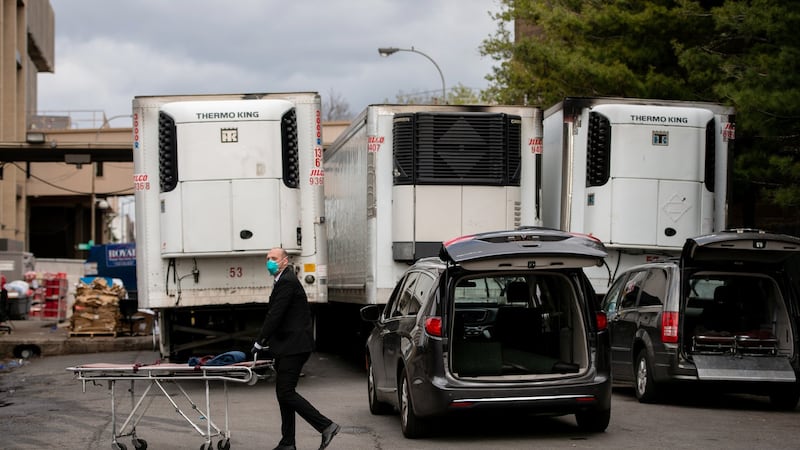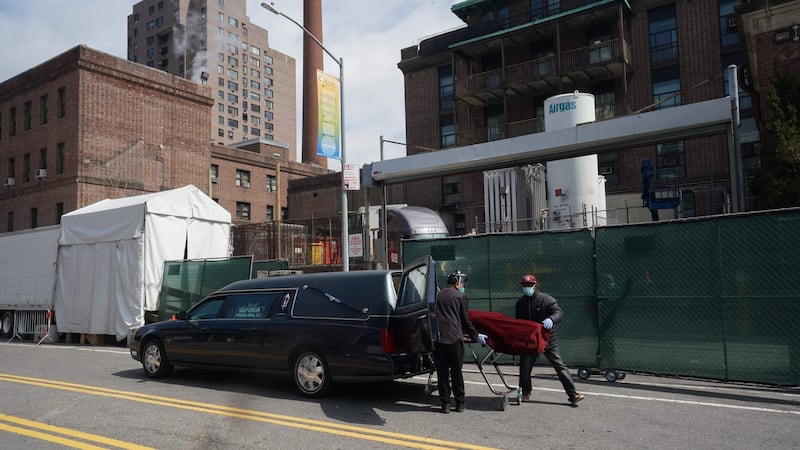Tom Habermann collected six bodies. They had come off refrigerated trucks, where they had been piled three or four high. The attendants who helped him, usually familiar faces, were strangers. The bodies were large. His shoulder hurt.
“It’s like a bomb dropped and nobody was prepared for it,” Habermann said.
Such is the plight of a funeral director in the Queens borough of New York city that is the centre of America’s coronavirus pandemic. In normal times, Habermann might conduct two or three funerals a week.


“We’re getting 40, 50, 60 calls a day,” he said. “There are other funeral homes in the neighbourhood that aren’t even answering their phone.”
Just as coronavirus has threatened to overwhelm New York’s healthcare system with a surge of patients, it is also taxing its “deathcare” system, clogging the morgues, cemeteries and funeral homes that process the bodies and convey them to their final resting places.
New York city has tried to cope by erecting temporary mortuary facilities and deploying 40 or so refrigerated trucks at hospitals around the city. A member of the city council warned that it would soon begin burying bodies in public parks.
"Trenches will be dug for 10 caskets in a line. It will be done in a dignified, orderly – and temporary – manner. But it will be tough for New Yorkers to take," Andrew Levine, chairman of the health committee, wrote on Twitter. Levine subsequently walked those statements back.
Hart Island
Still, mayor Bill de Blasio was forced to acknowledge that the surging death rate – which topped 8,000 on Saturday – will probably force the city to bury some of the dead on Hart Island, the Dickensian public cemetery in the Long Island Sound that is run by the prison system.
Since 1869, it has become the resting place for roughly one million poor and unclaimed New Yorkers, including victims of the 1918 influenza pandemic, the Aids epidemic, the homeless and the stillborn. Recent drone footage showing workers on the island, clad in protective gear and burying rows of caskets, has created a stir.
“Everybody’s in a panic,” Habermann said of the people who appeal to him each day. “Their fear is that their loved one will just become a number.”
As the crisis has dragged on, he and other funeral directors have become vital – and unacknowledged – frontline troops. Some say they have been working for weeks now without a day off. The conditions are dangerous because the bodies they are handling are contaminated with coronavirus. They are also physically exhausting. “A lot of the bodies I’m dealing with are big,” he explained. “They’re large.”
Most families opt for cremation, which is less expensive than a burial. “People don’t have the money,” Habermann said, particularly to deal with untimely deaths.
Given the backlog, there is a clamour to rush the bodies through the system. But, like the city’s intensive care units, it was not designed to cope with such volume. Habermann, for example, can hold about 15 bodies at most in his funeral home, accepting new ones only when existing ones are laid to rest. There is a two-week backlog at the city’s cemeteries and crematoriums.
There is also the demand to collect bodies from homes, where 200 or so New Yorkers are dying each day – roughly 10 times more than usual. Many are suspected of being coronavirus victims, although they are not tested and, therefore, not counted as such.
“Everybody says take the body out, take the body out. But there’s nowhere to put it,” Habermann explained.
In Queens, the lucky few who find a funeral home able to accommodate them are likely to be disappointed by what follows. Habermann tries to give a small number of family members an hour or so with the casket. Because of social distancing rules, there are no religious services or military honours allowed. Most cemeteries will require mourners to remain in their cars.
Still, it is better than Hart Island. Habermann visited it early in his career for a disinterment. The island, which has also served as a civil war prisoner-of-war camp and as a tuberculosis sanatorium, is reached by a special ferry from the Bronx operated by the department of correction. The bodies were handled by inmates. Still, professional courtesy prevailed.
“What you did is you actually brought them a carton of cigarettes for a tip,” Habermann recalled.
That may no longer be the custom. Given the dangers of coronavirus, the city has reportedly switched to using contract labourers. According to Habermann: “The inmates don’t even want to do it now.” – Copyright The Financial Times Limited 2020


















